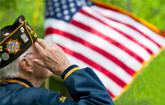Honor Flight Brings "Greatest Generation" to Visit WW II Memorial
WASHINGTON, May 27, 2011 /PRNewswire-USNewswire/ -- They got off the plane and came through the gate. Some were a bit startled by the cheering crowd, hand-shaking well-wishers and musicians performing Big Band and military favorites.
(Photo: http://photos.prnewswire.com/prnh/20110527/DC10561)
All of them came to Washington to see the World War II Memorial, the monument built for the "Greatest Generation" of warriors who fought from the frozen tundra of Alaska to the searing deserts of North Africa and steaming hellholes of Burma.
On May 25, U.S. Airways brought about 100 of our World War II heroes from Myrtle Beach, S.C. to visit – for the first time in their lives – the memorial built for them in Washington.
Members of American Legion Post 139 in Arlington, Va., greeted the contingent as they arrived through Gate 38 at Reagan International Airport.
"I'm a Vietnam veteran and I believe in what the Legion does, so it's important to me to be here to greet these World War II veterans," said Klaus Dahlke, post commander. "It means a lot to us, to welcome them and see their responses."
Dahlke's wife, Betty Ann, is president of the post's American Legion Auxiliary unit. The two of them have been greeting Honor Flight veterans for several years since 2005.
Other Legionnaires from several posts in Virginia – along with a Sons of The American Legion representative – greeted the veterans as they arrived via buses at the memorial.
"Bob and Elizabeth Dole are down here very frequently, and the guys love to see them," said Tom Wahl, commander of American Legion Post 10 in Manassas, Va. "They're both very gracious with the vets. We'll take all kinds of pictures. They'll spend all day down here."
How did it feel for these veterans to finally visit the memorial built in their honor?
"The memorial is unbelievable. I didn't even realize it was here, and now I've seen it," said James Johnston, a 90-year-old Army veteran who served in an anti-aircraft artillery battalion. "I'm very fortunate to be here."
Harry Brown, 87, also felt fortunate to be there. He saw action with the Navy Seabees (construction battalions) in the Philippines. "I'm getting up there in age. Maybe I won't be here next year. So I finally made it." Three days before the trip, Brown broke his right foot. That didn't stop him; he just toured the memorial in a wheelchair.
An 85-year-old Marine and Navy veteran, Earl Small, took part in the Okinawa invasion of April 1945. The battle lasted nearly three months and was the largest amphibious landing in the Pacific theater. When it was over, the Allies suffered more than 50,000 casualties.
"I went through the whole campaign without getting hit or anything," Small said. "I'm 85 and still going." He served 39 years on active and reserve duty, first as a Marine and then as a Navy yeoman, which he "didn't like at all. I didn't like the typewriter. They talked me into doing that and I was sorry I ever did it."
A 30-year Army Air Corps and Air Force veteran, Charlie Rogers was a flight engineer in cargo planes and B-24 Liberator bombers. Operating out of New Guinea, Rogers kept tabs on the plane's operating systems – and the pilots.
"Many times I have corrected a pilot because he grabbed the wrong controls," Rogers said. The pilots always appreciated his help, all except for one: "He was so arrogant. He wouldn't listen to me."
B-24 heavy bombers flew in every theater of World War II and remain America's most-produced military aircraft, with 18,400 copies.
One veteran at the memorial served in World War II, Korea and Vietnam. As a crew member in the Navy submarine USS Finback (SS 230), Andrew Palenchar was on board when the sub pulled a downed pilot out of the Pacific: George H.W. Bush.
While Palenchar was staying in Alexandria, Va., for a year, he "seemed to never have the time to come and visit. Now I'm in Denver, Colorado, and my daughter and I came to visit. And it's very enjoyable. It's just outstanding."
Two more World War II veterans, Howard Moore and Donald Moler, both served in the Pacific theater: Moore as an Army Air Corps navigator in B-24s and Moler as a Navy postmaster.
Moore said he had a "fabulous" experience in the Army Air Corps. "Being so young at that time, nothing fazed us. We had a lot of courage. We probably didn't know exactly what we were doing at the time, but we were eager to do it."
Moler joined the Navy one day before he turned 18 and delivered mail to sailors and Marines throughout the Pacific, ending up in Japan as part of our occupation force.
During the war, Moler said "Mailmen were well loved. If there's anything a military man wanted to see, it was the guy with the mail."
Recalling his own mail calls in the Pacific, Moore said "Love letters and edibles. They were very welcome." What kind of edibles? "Cookies, mostly," he said, smiling. "They traveled very well."
Referring to the reception their Honor Flight from Myrtle Beach, S.C., received after it landed in Washington, Moore said the World War II veterans "were overwhelmed by the people just appreciating our service. It was touching. Very touching."
"The reception at Reagan National Airport was just tremendous," Moler said. "The both of us had tears in our eyes because of that welcome."
SOURCE The American Legion
WANT YOUR COMPANY'S NEWS FEATURED ON PRNEWSWIRE.COM?
Newsrooms &
Influencers
Digital Media
Outlets
Journalists
Opted In



Share this article